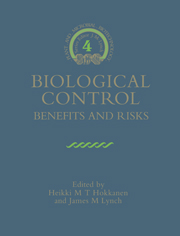Book contents
- Frontmatter
- Contents
- List of Contributors
- Series Preface
- Preface: Overview of Benefits and Risks of Biological Control Introductions
- Part I Biological Invasions
- Part II Classical Biocontrol
- 5 Benefits and Risks of Classical Biological Control
- 6 Potential Impacts on Threatened and Endangered Insects Species in the United States from Introductions of Parasitic Hymenoptera for the Control of Insect Pests
- 7 Lessons from Post-release Investigations in Classical Biological Control: The Case of Microctonus aethiopoides Loan (Hym., Braconidae) Introduced into Australia and New Zealand for the Biological Control of Sitona discoideus Gyllenhal (Col., Curculionidae)
- 8 Host Specificity Screening of Insect Biological Weed Control Agents as Part of an Environmental Risk Assessment
- Part III Augmentative Biocontrol
- Part IV Use of Genetically Modified Organisms
- Part V Economics and Registration
- Index
7 - Lessons from Post-release Investigations in Classical Biological Control: The Case of Microctonus aethiopoides Loan (Hym., Braconidae) Introduced into Australia and New Zealand for the Biological Control of Sitona discoideus Gyllenhal (Col., Curculionidae)
Published online by Cambridge University Press: 07 May 2010
- Frontmatter
- Contents
- List of Contributors
- Series Preface
- Preface: Overview of Benefits and Risks of Biological Control Introductions
- Part I Biological Invasions
- Part II Classical Biocontrol
- 5 Benefits and Risks of Classical Biological Control
- 6 Potential Impacts on Threatened and Endangered Insects Species in the United States from Introductions of Parasitic Hymenoptera for the Control of Insect Pests
- 7 Lessons from Post-release Investigations in Classical Biological Control: The Case of Microctonus aethiopoides Loan (Hym., Braconidae) Introduced into Australia and New Zealand for the Biological Control of Sitona discoideus Gyllenhal (Col., Curculionidae)
- 8 Host Specificity Screening of Insect Biological Weed Control Agents as Part of an Environmental Risk Assessment
- Part III Augmentative Biocontrol
- Part IV Use of Genetically Modified Organisms
- Part V Economics and Registration
- Index
Summary
Introduction
Species of the genus Sitona Germar (Col., Curculionidae) have been recorded on all continents and all develop at the expense of a number of Leguminosae. In their larval stages, they attack the root system and may be especially injurious to the nodules (Aeschlimann, 1986), whereas the longlived adults consume the stems and foliage of their host plants. The four palaearctic representatives which comprise the S. humeralis group of species all depend upon Medicago spp. as host plants (Aeschlimann, 1984). One of these, S. discoideus Gyllenhal, was accidentally introduced into the southern hemisphere, where it has become a pest of economic importance to both perennial cultivated lucerne and volunteer annual Medicago species used for pasture throughout southeastern Australia and subsequently in the south island of New Zealand.
As a consequence of the importance of S. discoideus, surveys were carried out from 1973 to 1985 over most of the Mediterranean basin (Aeschlimann, 1980) with the aim of identifying efficient natural enemies of the various stages of S. discoideus that would be suitable for deliberate introduction into Australia. These investigations demonstrated that the parasitoid Microctonus aethiopoides Loan (Hym., Euphorinae) was the most promising biological control agent for use against adult Sitona weevils. Based on these findings, several biotypes of this natural enemy were imported between 1975 and 1979 from various parts of the western Mediterranean region to Australia for mass-rearing in quarantine and subsequent field release against S. discoideus (Aeschlimann, 1983a). Initial establishment followed by spreading was recorded in Australia 2 years after the start of the release programme (Aeschlimann, 1983a).
- Type
- Chapter
- Information
- Biological ControlBenefits and Risks, pp. 75 - 83Publisher: Cambridge University PressPrint publication year: 1995
- 9
- Cited by

